 Technology peripherals
Technology peripherals
 AI
AI
 'Censored' during image generation: Failure cases of stable diffusion are affected by four major factors
'Censored' during image generation: Failure cases of stable diffusion are affected by four major factors
'Censored' during image generation: Failure cases of stable diffusion are affected by four major factors
Text-to-image diffusion generation models, such as Stable Diffusion, DALL-E 2 and mid-journey, have been in a state of vigorous development and have strong text-to-image generation capabilities, but "overturned ” Cases will occasionally appear.
As shown in the figure below, when given a text prompt: "A photo of a warthog", the Stable Diffusion model can generate a corresponding, clear and realistic photo of a warthog. However, when we slightly modify this text prompt and change it to: "A photo of a warthog and a traitor", what about the warthog? How did it become a car?
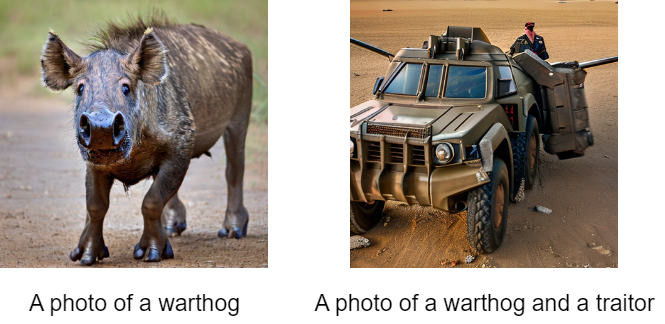
Let’s take a look at the next few examples. What new species are these?
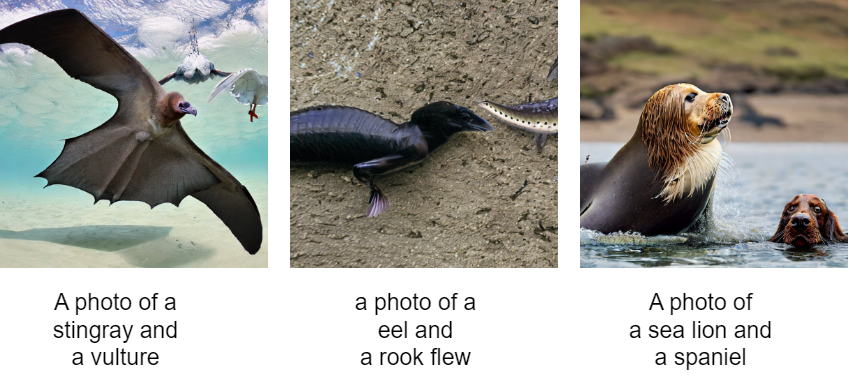
What causes these strange phenomena? These generation failure cases all come from a recently published paper "Stable Diffusion is Unstable":
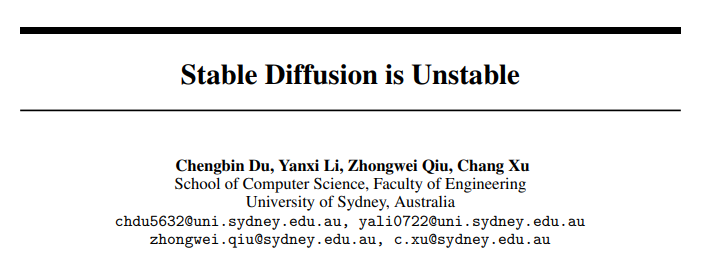
- Paper address: https://arxiv.org/abs/2306.02583
In this paper A gradient-based adversarial algorithm for text-to-image models is proposed for the first time. This algorithm can efficiently and effectively generate a large number of offensive text prompts, and can effectively explore the instability of the Stable diffusion model. This algorithm achieved an attack success rate of 91.1% on short text prompts and 81.2% on long text prompts. In addition, this algorithm provides rich cases for studying the failure modes of text-to-image generation models, laying a foundation for research on the controllability of image generation.
Based on a large number of generation failure cases generated by this algorithm, the researcher summarized four reasons for generation failure, which are:
- Difference in generation speed
- Similarity of coarse-grained features
- Ambiguity of words
- The position of the word in the prompt
Difference in generation speed
When a prompt (prompt) contains multiple generation targets, we often encounter There is an issue where a certain target disappears during the generation process. Theoretically, all targets within the same cue should share the same initial noise. As shown in Figure 4, the researchers generated one thousand category targets on ImageNet under the condition of fixed initial noise. They used the last image generated by each target as a reference image and calculated the Structural Similarity Index (SSIM) score between the image generated at each time step and the image generated at the last step to demonstrate the different targets. Differences in build speed.
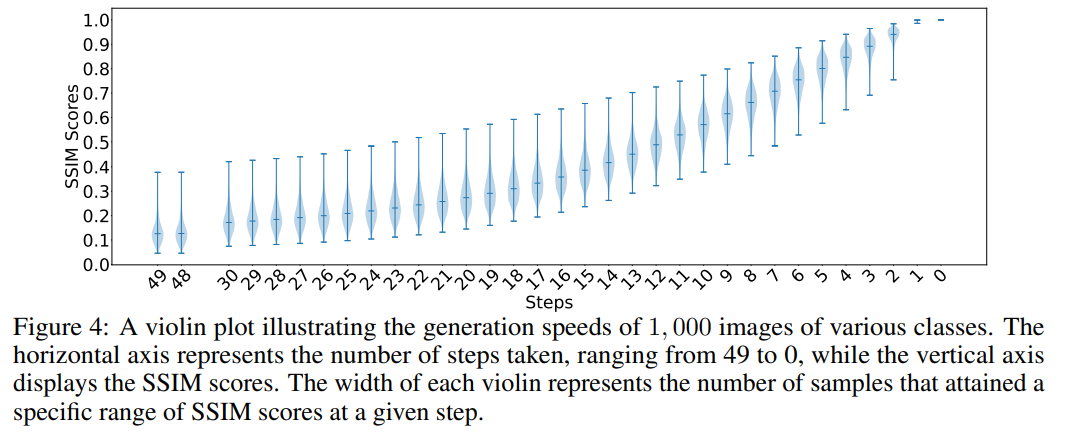
Coarse-grained feature similarity
In the diffusion generation process, the researcher found that when When there is global or local coarse-grained feature similarity between two types of targets, problems will arise when calculating cross attention weights. This is because the two target nouns may focus on the same block of the same picture at the same time, resulting in feature entanglement. For example, in Figure 6, feather and silver salmon have certain similarities in coarse-grained features, which results in feather being able to continue to complete its generation task in the eighth step of the generation process based on silver salmon. For two types of targets without entanglement, such as silver salmon and magician, magician cannot complete its generation task on the intermediate step image based on silver salmon.

Polysemy
In this chapter, researchers explore in depth what happens when a word has multiple meanings time generation. What they found was that, without any outside perturbation, the resulting image often represented a specific meaning of the word. Take "warthog" as an example. The first line in Figure A4 is generated based on the meaning of the word "warthog".
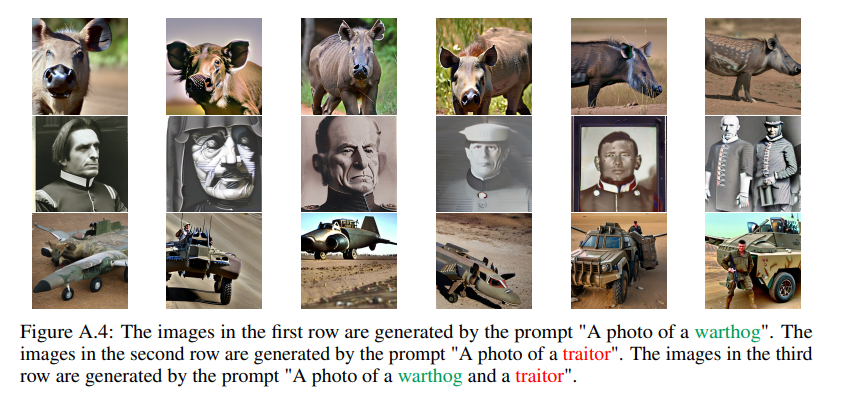
However, researchers also found that when other words are injected into the original prompt , which may cause semantic shifts. For example, when the word "traitor" is introduced in a prompt describing "warthog", the generated image content may deviate from the original meaning of "warthog" and generate entirely new content.
The position of the word in prompt
In Figure 10, the researcher observed an interesting phenomenon. Although from a human perspective, the prompts arranged in different orders generally have the same meaning, they are all describing a picture of a cat, clogs, and a pistol. However, for the language model, that is, the CLIP text encoder, the order of the words affects its understanding of the text to a certain extent, which in turn changes the content of the generated images. This phenomenon shows that although our descriptions are semantically consistent, the model may produce different understanding and generation results due to the different order of words. This not only reveals that the way models process language and understands semantics is different from humans, but also reminds us that we need to pay more attention to the impact of word order when designing and using such models.

Model structure
As shown in Figure 1 below, without changing the original target noun in the prompt Under the premise, the researcher continuousizes the discrete process of word replacement or expansion by learning the Gumbel Softmax distribution, thereby ensuring the differentiability of perturbation generation. After generating the image, the CLIP classifier and margin loss are used to optimize ω, aiming to generate CLIP For images that cannot be correctly classified, in order to ensure that offensive cues have a certain similarity with clean cues, researchers have further used semantic similarity constraints and text fluency constraints.
Once this distribution is learned, the algorithm is able to sample multiple text prompts with attack effects for the same clean text prompt.
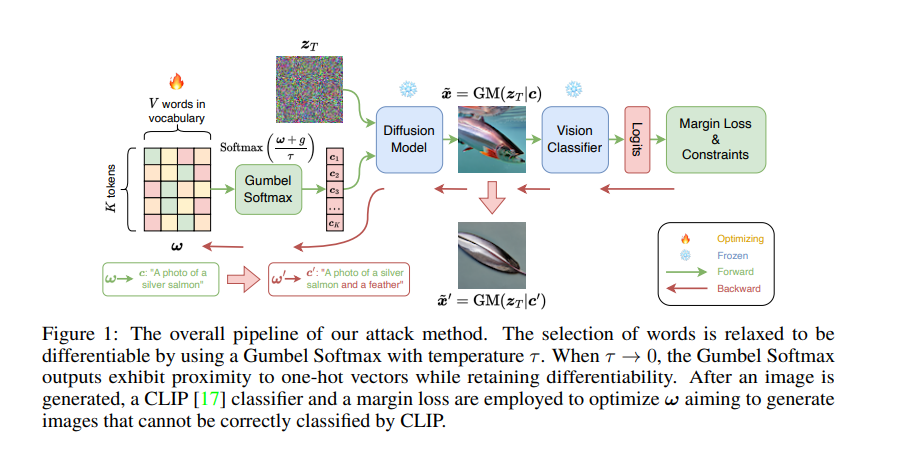

# See the original article for more details.
The above is the detailed content of 'Censored' during image generation: Failure cases of stable diffusion are affected by four major factors. For more information, please follow other related articles on the PHP Chinese website!

Hot AI Tools

Undresser.AI Undress
AI-powered app for creating realistic nude photos

AI Clothes Remover
Online AI tool for removing clothes from photos.

Undress AI Tool
Undress images for free

Clothoff.io
AI clothes remover

AI Hentai Generator
Generate AI Hentai for free.

Hot Article

Hot Tools

Notepad++7.3.1
Easy-to-use and free code editor

SublimeText3 Chinese version
Chinese version, very easy to use

Zend Studio 13.0.1
Powerful PHP integrated development environment

Dreamweaver CS6
Visual web development tools

SublimeText3 Mac version
God-level code editing software (SublimeText3)

Hot Topics
 1378
1378
 52
52
 The world's most powerful open source MoE model is here, with Chinese capabilities comparable to GPT-4, and the price is only nearly one percent of GPT-4-Turbo
May 07, 2024 pm 04:13 PM
The world's most powerful open source MoE model is here, with Chinese capabilities comparable to GPT-4, and the price is only nearly one percent of GPT-4-Turbo
May 07, 2024 pm 04:13 PM
Imagine an artificial intelligence model that not only has the ability to surpass traditional computing, but also achieves more efficient performance at a lower cost. This is not science fiction, DeepSeek-V2[1], the world’s most powerful open source MoE model is here. DeepSeek-V2 is a powerful mixture of experts (MoE) language model with the characteristics of economical training and efficient inference. It consists of 236B parameters, 21B of which are used to activate each marker. Compared with DeepSeek67B, DeepSeek-V2 has stronger performance, while saving 42.5% of training costs, reducing KV cache by 93.3%, and increasing the maximum generation throughput to 5.76 times. DeepSeek is a company exploring general artificial intelligence
 AI subverts mathematical research! Fields Medal winner and Chinese-American mathematician led 11 top-ranked papers | Liked by Terence Tao
Apr 09, 2024 am 11:52 AM
AI subverts mathematical research! Fields Medal winner and Chinese-American mathematician led 11 top-ranked papers | Liked by Terence Tao
Apr 09, 2024 am 11:52 AM
AI is indeed changing mathematics. Recently, Tao Zhexuan, who has been paying close attention to this issue, forwarded the latest issue of "Bulletin of the American Mathematical Society" (Bulletin of the American Mathematical Society). Focusing on the topic "Will machines change mathematics?", many mathematicians expressed their opinions. The whole process was full of sparks, hardcore and exciting. The author has a strong lineup, including Fields Medal winner Akshay Venkatesh, Chinese mathematician Zheng Lejun, NYU computer scientist Ernest Davis and many other well-known scholars in the industry. The world of AI has changed dramatically. You know, many of these articles were submitted a year ago.
 KAN, which replaces MLP, has been extended to convolution by open source projects
Jun 01, 2024 pm 10:03 PM
KAN, which replaces MLP, has been extended to convolution by open source projects
Jun 01, 2024 pm 10:03 PM
Earlier this month, researchers from MIT and other institutions proposed a very promising alternative to MLP - KAN. KAN outperforms MLP in terms of accuracy and interpretability. And it can outperform MLP running with a larger number of parameters with a very small number of parameters. For example, the authors stated that they used KAN to reproduce DeepMind's results with a smaller network and a higher degree of automation. Specifically, DeepMind's MLP has about 300,000 parameters, while KAN only has about 200 parameters. KAN has a strong mathematical foundation like MLP. MLP is based on the universal approximation theorem, while KAN is based on the Kolmogorov-Arnold representation theorem. As shown in the figure below, KAN has
 Google is ecstatic: JAX performance surpasses Pytorch and TensorFlow! It may become the fastest choice for GPU inference training
Apr 01, 2024 pm 07:46 PM
Google is ecstatic: JAX performance surpasses Pytorch and TensorFlow! It may become the fastest choice for GPU inference training
Apr 01, 2024 pm 07:46 PM
The performance of JAX, promoted by Google, has surpassed that of Pytorch and TensorFlow in recent benchmark tests, ranking first in 7 indicators. And the test was not done on the TPU with the best JAX performance. Although among developers, Pytorch is still more popular than Tensorflow. But in the future, perhaps more large models will be trained and run based on the JAX platform. Models Recently, the Keras team benchmarked three backends (TensorFlow, JAX, PyTorch) with the native PyTorch implementation and Keras2 with TensorFlow. First, they select a set of mainstream
 Hello, electric Atlas! Boston Dynamics robot comes back to life, 180-degree weird moves scare Musk
Apr 18, 2024 pm 07:58 PM
Hello, electric Atlas! Boston Dynamics robot comes back to life, 180-degree weird moves scare Musk
Apr 18, 2024 pm 07:58 PM
Boston Dynamics Atlas officially enters the era of electric robots! Yesterday, the hydraulic Atlas just "tearfully" withdrew from the stage of history. Today, Boston Dynamics announced that the electric Atlas is on the job. It seems that in the field of commercial humanoid robots, Boston Dynamics is determined to compete with Tesla. After the new video was released, it had already been viewed by more than one million people in just ten hours. The old people leave and new roles appear. This is a historical necessity. There is no doubt that this year is the explosive year of humanoid robots. Netizens commented: The advancement of robots has made this year's opening ceremony look like a human, and the degree of freedom is far greater than that of humans. But is this really not a horror movie? At the beginning of the video, Atlas is lying calmly on the ground, seemingly on his back. What follows is jaw-dropping
 FisheyeDetNet: the first target detection algorithm based on fisheye camera
Apr 26, 2024 am 11:37 AM
FisheyeDetNet: the first target detection algorithm based on fisheye camera
Apr 26, 2024 am 11:37 AM
Target detection is a relatively mature problem in autonomous driving systems, among which pedestrian detection is one of the earliest algorithms to be deployed. Very comprehensive research has been carried out in most papers. However, distance perception using fisheye cameras for surround view is relatively less studied. Due to large radial distortion, standard bounding box representation is difficult to implement in fisheye cameras. To alleviate the above description, we explore extended bounding box, ellipse, and general polygon designs into polar/angular representations and define an instance segmentation mIOU metric to analyze these representations. The proposed model fisheyeDetNet with polygonal shape outperforms other models and simultaneously achieves 49.5% mAP on the Valeo fisheye camera dataset for autonomous driving
 Tesla robots work in factories, Musk: The degree of freedom of hands will reach 22 this year!
May 06, 2024 pm 04:13 PM
Tesla robots work in factories, Musk: The degree of freedom of hands will reach 22 this year!
May 06, 2024 pm 04:13 PM
The latest video of Tesla's robot Optimus is released, and it can already work in the factory. At normal speed, it sorts batteries (Tesla's 4680 batteries) like this: The official also released what it looks like at 20x speed - on a small "workstation", picking and picking and picking: This time it is released One of the highlights of the video is that Optimus completes this work in the factory, completely autonomously, without human intervention throughout the process. And from the perspective of Optimus, it can also pick up and place the crooked battery, focusing on automatic error correction: Regarding Optimus's hand, NVIDIA scientist Jim Fan gave a high evaluation: Optimus's hand is the world's five-fingered robot. One of the most dexterous. Its hands are not only tactile
 DualBEV: significantly surpassing BEVFormer and BEVDet4D, open the book!
Mar 21, 2024 pm 05:21 PM
DualBEV: significantly surpassing BEVFormer and BEVDet4D, open the book!
Mar 21, 2024 pm 05:21 PM
This paper explores the problem of accurately detecting objects from different viewing angles (such as perspective and bird's-eye view) in autonomous driving, especially how to effectively transform features from perspective (PV) to bird's-eye view (BEV) space. Transformation is implemented via the Visual Transformation (VT) module. Existing methods are broadly divided into two strategies: 2D to 3D and 3D to 2D conversion. 2D-to-3D methods improve dense 2D features by predicting depth probabilities, but the inherent uncertainty of depth predictions, especially in distant regions, may introduce inaccuracies. While 3D to 2D methods usually use 3D queries to sample 2D features and learn the attention weights of the correspondence between 3D and 2D features through a Transformer, which increases the computational and deployment time.



